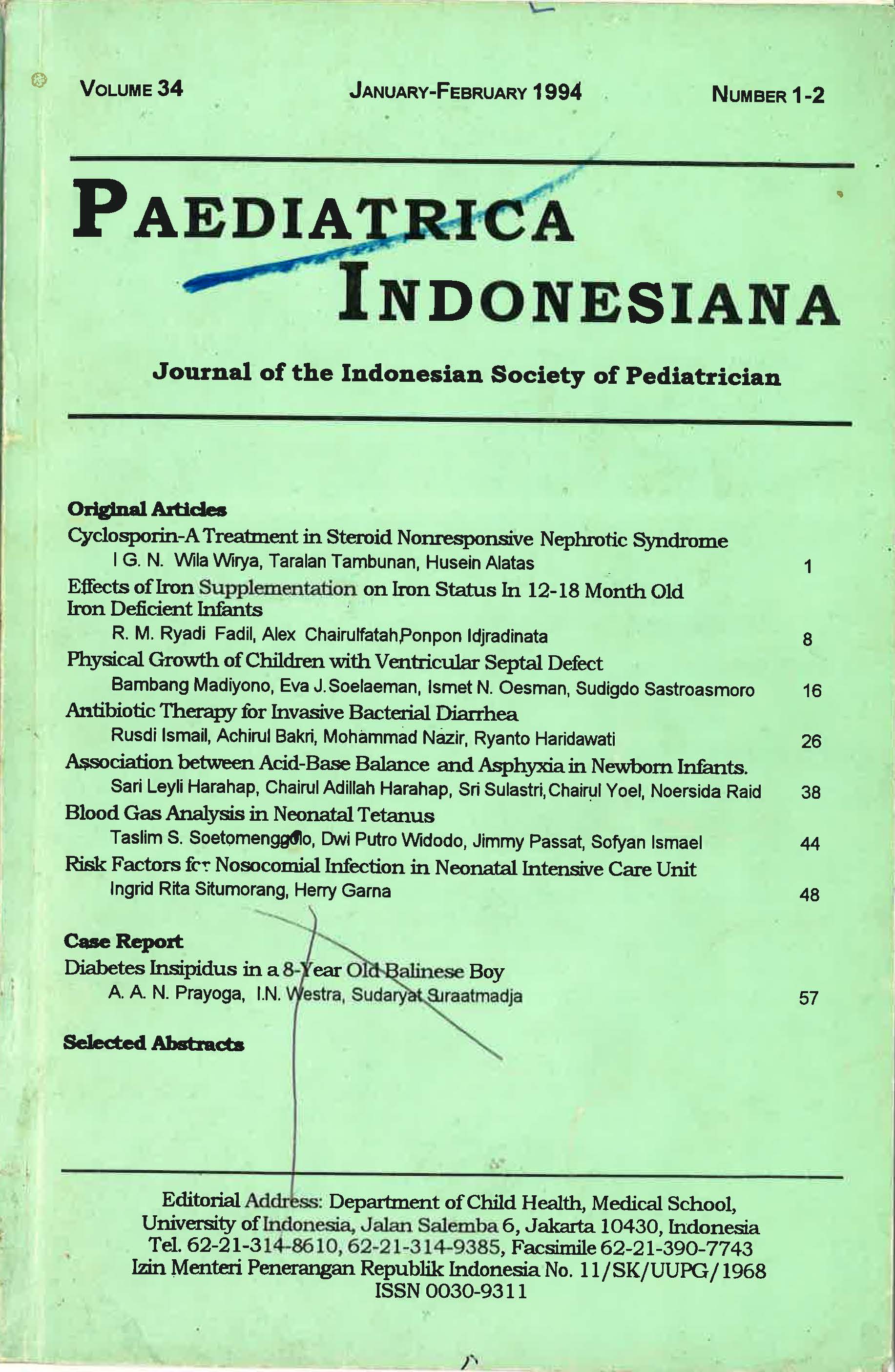Association between Acid-Base Balance and Asphyxia in Newborn Infants
Abstract
We performed a prospective study on the association between acid-base balance and asphyxta based on Apgar scores in 45 newborn babies admitted to the Division of Perinatology, Pirngadi Hospital, Medan, from January 1 to February 28, 1993. Blood gas analysis was done on blood obtained from umbilical artery. Based on 1st and 5th minutes Apgar scores, 40 (88.9%) and 21 babies (46.7%}, respectively, had asphyxia. Relation to acid-base balance was determined with the sensitivity of the 5th minute Apgar score in predicting acidotic states. It was found that Apgar score had sensitivity of 57.7% and specificity of 68.4% in predicting the acidotic states. Apgar score of > 7 was unable to. exclude the possible acidosis in 45% of cases (negative predictive value 54.1%). Gestational age had no influence on Apgar Scores. Apgar score was more sensitive to eliminate suspected acidosis in term neonates than in preterms. We recommend to perform umbilical arterial blood gas analysis to determine acidotic state in high risk newborn infants.
References
2. Golden SM, Peters D. Delivery room cake, in neonatal intensive care, 1985:31-42.
3. Wilmana FK. Gangguan asam basa. ln: Tinjauan klinis atas hasil pemeriksaan laboratorium; 9th ed. Jakarta: Bagian Patologi Klinik FKUI-RSCM; 288-300.
4. Modanlou HC, Yeti SY, Hon EH, Forsythe A. Fetal and neonatal biochemistry and Apgar scores. Am J Obstet Gynaecol 1973;117:942-51.
5. Sykes GS. Do Apgar scores indicate asphyxia? Lancet 1982;494-6.
6. Crawford, JS, Danes P, Pearson JF. Significance of the individual components of the Apgar score. J Anaesthesia 1973; 45: 148-58.
7. Wahyoeningsih S, Arifin S, Sulistyono H. Relation of fetal asphyxia and Apgar score. J Anest Crit Care, 1987 ;5:28-33.
8. Catlin, EA. The Apgar score revisited, influence of gestational age. J Pediat 1986; 109:865-8 .
9. De Souza SW, John RW, Richards B, Milner, RDG. Fetal distress and birth scores in newborn infants. Arch. Dis. in childhood 1975;50:920-5.
10. Goldenberg, RL, Huddleston, JF, Nelson, KG. Apgar scores and umbilical arterial pH in preterm newborn infants Am J Obstet Gynaecol 1984;149:651-4.
Copyright (c) 2018 Sari Leyli Harahap, Chairul Adillah Harahap, Sri Sulastri, Chairul Yoel, Noersida Raid

This work is licensed under a Creative Commons Attribution-NonCommercial-ShareAlike 4.0 International License.
Authors who publish with this journal agree to the following terms:
Authors retain copyright and grant the journal right of first publication with the work simultaneously licensed under a Creative Commons Attribution License that allows others to share the work with an acknowledgement of the work's authorship and initial publication in this journal.
Authors are able to enter into separate, additional contractual arrangements for the non-exclusive distribution of the journal's published version of the work (e.g., post it to an institutional repository or publish it in a book), with an acknowledgement of its initial publication in this journal.
Published 2018-11-01













